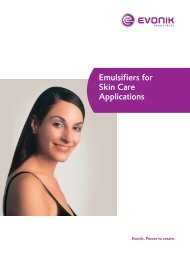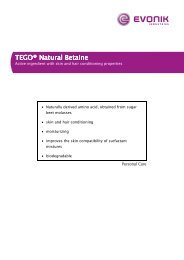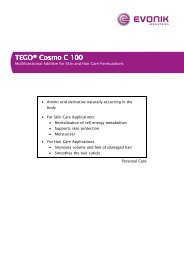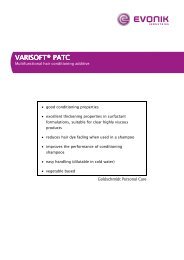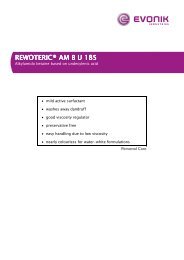Hair Types and Required Specific Ingredients for Conditioning ...
Hair Types and Required Specific Ingredients for Conditioning ...
Hair Types and Required Specific Ingredients for Conditioning ...
You also want an ePaper? Increase the reach of your titles
YUMPU automatically turns print PDFs into web optimized ePapers that Google loves.
2. <strong>Conditioning</strong> Needs <strong>for</strong> Different <strong>Hair</strong> <strong>Types</strong><br />
<strong>Hair</strong> conditioning products have to provide a wide variety of different properties. The properties that are specific to a need are<br />
claimed on the package, others are simply implied. The most important properties that need to be addressed in a hair conditioner are:<br />
• detangling/wet comb<br />
• wet feel<br />
• dry comb improved (lower <strong>for</strong>ce)<br />
• dry comb reduced (higher <strong>for</strong>ce, provides hold of the style)<br />
• dry feel<br />
• gloss/shine<br />
• style retention (reduced curl droop)<br />
• straightening effect (weighing down, poor volume)<br />
• volume/body<br />
• antistatic effect<br />
• color protection<br />
• hair strengthening properties<br />
Looking into this list of conditioning effect one may think, that all of them are requested in any case. This is true, but<br />
nevertheless, the most important parameters do differ between specific hair types. Figure 2 shows an overview about<br />
the specific conditioning needs of the various hair types, which already have been described in chapter 1. The crosses<br />
symbolise the “primary” importance of need, the circles symbolise the “secondary” need <strong>for</strong> property improvement.<br />
Improvement of detangling/wet combability is important <strong>for</strong> all hair types, because this property is immediately<br />
perceived by the consumer.<br />
The improvement of the wet feel is mostly important <strong>for</strong> colored hair which feels very hard <strong>and</strong> rough when wet.<br />
The parameter “dry combing” has to be differentiated: fine hair does not necessarily need reduced dry combing <strong>for</strong>ces,<br />
because this would lead to a reduced volume related to the lower friction between the single fibers. But thick hair <strong>and</strong><br />
curly hair types generally do need to be smooth in the dry stage, especially if they are chemically treated.<br />
Dry feel is also one of the parameters, which are detected by the consumers immediately <strong>and</strong> is there<strong>for</strong>e important <strong>for</strong><br />
all hair types.<br />
Gloss/shine is mostly important <strong>for</strong> straight hair, because curly hair has a structure related low shiny appearance.<br />
Colored hair needs to have a gloss improvement.<br />
An improved hold of the hairstyle is mostly interesting <strong>for</strong> fine <strong>and</strong> normal hair.<br />
This plays also a role in minimizing the frizzyness of curly hair. For this type of hair, defined curls or even straight styled<br />
hair is desired.<br />
A straightening effect is desired <strong>for</strong> the thick hair type. The opposite, an increased volume/body is desired <strong>for</strong> fine<br />
<strong>and</strong> normal hair with exception of the permed types (because the perming treatment already increase the volume).<br />
An antistatic effect is mostly interesting <strong>for</strong> the chemically treated fine <strong>and</strong> normal hair because of the lowered<br />
isoelectric point of the hair keratin.<br />
An improved color protection is essential <strong>for</strong> colored hair, esp. <strong>for</strong> the very modern intensely red colored hair. The red<br />
pigments are much smaller than others <strong>and</strong> there<strong>for</strong>e may be washed out more easily.<br />
The table in Figure 2 summarizes the specific conditioning needs of the various hair types.<br />
4



